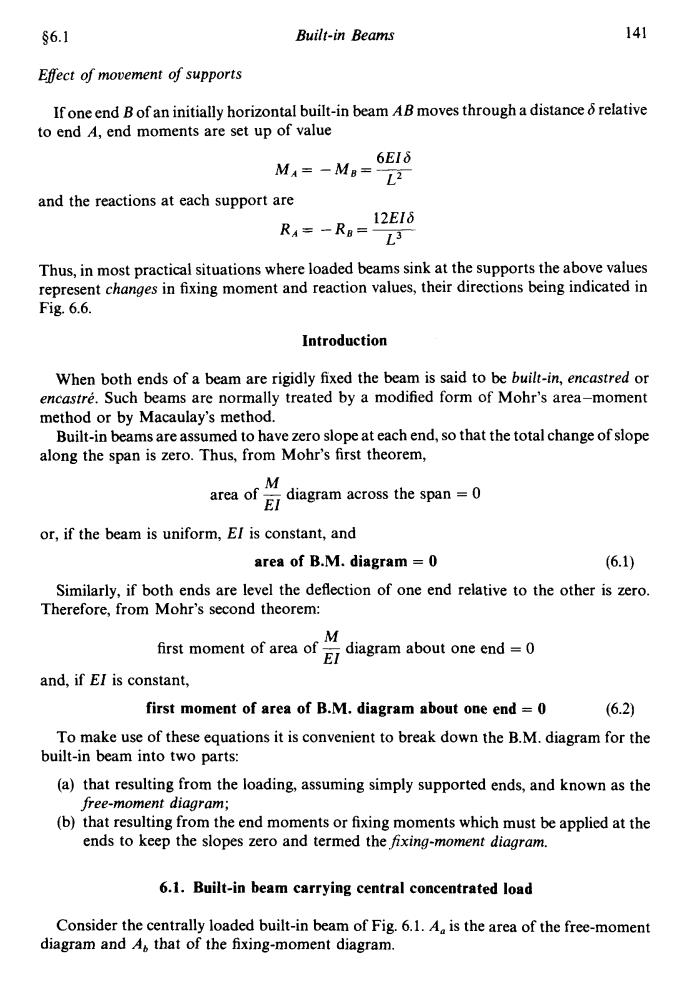正在加载图片...

§6.1 Built-in Beams 141 Effect of movement of supports If one end B of an initially horizontal built-in beam AB moves through a distance o relative to end A,end moments are set up of value 6E18 MA=-MB=Li and the reactions at each support are 12EI6 RA=-RB=L3 Thus,in most practical situations where loaded beams sink at the supports the above values represent changes in fixing moment and reaction values,their directions being indicated in Fig.6.6. Introduction When both ends of a beam are rigidly fixed the beam is said to be built-in,encastred or encastre.Such beams are normally treated by a modified form of Mohr's area-moment method or by Macaulay's method. Built-in beams are assumed to have zero slope at each end,so that the total change of slope along the span is zero.Thus,from Mohr's first theorem, area of M Ediagram across the span-0 or,if the beam is uniform,EI is constant,and area of B.M.diagram =0 (6.1) Similarly,if both ends are level the deflection of one end relative to the other is zero. Therefore,from Mohr's second theorem: 、M first moment of area ofdiagram about one end0 and,if EI is constant, first moment of area of B.M.diagram about one end =0 (6.2) To make use of these equations it is convenient to break down the B.M.diagram for the built-in beam into two parts: (a)that resulting from the loading,assuming simply supported ends,and known as the free-moment diagram; (b)that resulting from the end moments or fixing moments which must be applied at the ends to keep the slopes zero and termed the fixing-moment diagram. 6.1.Built-in beam carrying central concentrated load Consider the centrally loaded built-in beam of Fig.6.1.A is the area of the free-moment diagram and A that of the fixing-moment diagram.$6.1 Built-in Beams 141 Efect of movement of supports If one end B of an initially horizontal built-in beam AB moves through a distance 6 relative to end A, end moments are set up of value and the reactions at each support are Thus, in most practical situations where loaded beams sink at the supports the above values represent changes in fixing moment and reaction values, their directions being indicated in Fig. 6.6. Introduction When both ends of a beam are rigidly fixed the beam is said to be built-in, encastred or encastri. Such beams are normally treated by a modified form of Mohr’s area-moment method or by Macaulay’s method. Built-in beams are assumed to have zero slope at each end, so that the total change of slope along the span is zero. Thus, from Mohr’s first theorem, M. El area of - diagram across the span = 0 or, if the beam is uniform, El is constant, and area of B.M. diagram = 0 (6.1) Similarly, if both ends are level the deflection of one end relative to the other is zero. Therefore, from Mohr’s second theorem: M EI first moment of area of - diagram about one end = 0 and, if EZ is constant, first moment of area of B.M. diagram about one end = 0 (6.2) To make use of these equations it is convenient to break down the B.M. diagram for the (a) that resulting from the loading, assuming simply supported ends, and known as the (b) that resulting from the end moments or fixing moments which must be applied at the built-in beam into two parts: free-moment diagram; ends to keep the slopes zero and termed the fixing-moment diagram. 6.1. Built-in beam carrying central concentrated load Consider the centrally loaded built-in beam of Fig. 6.1. A, is the area of the free-moment diagram and A, that of the fixing-moment diagram